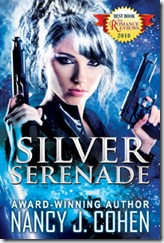You’ve read through your novel for the umpteenth time and can barely look at it anymore. Then your advance reading copy or final pdf file arrives, and it’s time for a last glance before sending your baby into the world. Will you still find changes to make? Undoubtedly. Sometimes these are conversion errors. Or you may notice typos or word choices that need a tweak.
Trimmed to Death, #15 in the Bad Hair Day Mysteries, is set to debut on Sept. 25. Check out the latest changes I’ve made and you’ll gain some insight into the mind of a writer. Caution – There may be spoilers.
p. 74 – bustled … bustle.
A few minutes later, Janet bustled down the stairs along with her housekeeper. After giving the woman an order and watching her bustle off toward another part of the house, Janet turned to Marla.
Change “bustle” to “scurry” so it reads …watching her scurry off…
p. 78 – “get involved” x 2
Janet clapped her hands. “It sounds wonderful. I’d love to get involved. Tony, you could ask Tristan to donate some of his desserts. You cross paths on occasion.” She turned to Marla. “His restaurant buys vegetables from our farm. They like to advertise how their dishes contain ingredients from sustainable food sources.”
“That would be amazing if his restaurant would get involved in our charity event. They’d benefit from the publicity as well.”
Change “I’d love to get involved” to “be included.” So it should say, I’d love to be included.
p. 103 –Marla winced. “I know what you mean. I’m wondering if you knew Francine Dodger, publisher of Eat Well Now magazine.
Delete “Marla winced” on this line. I use “wince” too many times.
p. 125 – “It says, ‘Meet me at midnight by the Living Tree. All hail Osiris.’ “
Last quote mark is reversed.
p. 148 – “You can tell, huh? Your dad called with bad news. Another woman is his case was found dead.” Change “is” to “in”
p. 154 – “Why are you so afraid, Janet?
Add quote mark at end of sentence
p. 161 – “Actually, I came to order lunch. Can get you get me a turkey delight to go?”
Can get you get me. Delete first “get”
p. 165 – “Lynette theorized that Francine would have made an effort to buy the magazine from the conglomerate that owns it.
Made an offer, not made an effort. Change effort to offer.
p. 170 – “I’ll give you a taste of our olive oil varieties after we return.”
Marla’s jaw dropped as she noticed the variety of goods for sale.
Varieties … variety. Change “variety” of goods to “range” of goods
p. 178 – Used “message” x 3.
Chills ran up Marla’s spine as she scanned the message. Mind your own business or you’ll be next.
[Chapter Break]
“It looks as though the message was printed on a sheet of white computer paper.” Marla snapped a photo and messaged it to Dalton.
Change “messaged” to “sent” in this last sentence.
p. 180 – The word “property” is used too many times.
“Without color of title means we’ve been paying property taxes and any liens on the property, as well as meeting the other conditions. Besides occupying the property for a minimum of seven years, we have to be in open use of the property, essentially acting as the sole owner.”
Change “occupying the property” to “occupying the place”
p. 199 – Used “man” x 3.
“If his column is losing readers, it’s because the man has lost his edge.”
“Could he have wanted to get her out of the way?” Dalton studied the other man’s face.
“Are you kidding? Man, that guy couldn’t hurt a fly. He doesn’t have it in him.”
Remove this “Man” and just say, “That guy couldn’t hurt a fly.
p. 204 – She could have quite a list of personal indiscretions hidden away. Change to: She could have had quite a … Add “had” in this sentence. This refers to the victim.
p. 231 – Used “took” x 2
The camera wasn’t in Francine’s purse and hasn’t been turned in by anyone.”
“Do you believe the killer took it?”
“It’s possible. The pictures Francine took could be useful to the case.”
Change to, Do you believe the killer kept it?
p. 249 – Referencing Marla’s stepdaughter in this paragraph:
Meanwhile, it promised to be a bumpy ride. Dalton likely wouldn’t approve of any guy she brought home for them to meet until he’d done a thorough background check and conducted a personal interview. She couldn’t blame the girl for being guarded about her love life and had to trust her to make the right decisions.
Change “she” to “Marla” in the beginning of this sentence to clarify: Marla couldn’t blame the girl for being guarded about her love life and had to trust her to make the right decisions.
Recipes:
p. 274: spice cake mix is not capitalized
p. 275: Yellow Cake Mix is capitalized
Choose one or the other for consistency
<><><>
It is not easy to scrutinize your work line-by-line and word-for-word, but this is part of the writing process. You want your book to be the best it can be, and this is the way. Positive feedback from readers makes it all worthwhile. CLICK TO TWEET
GIVEAWAY
Enter Here to win a $25 Amazon/BN gift card from Booklover’s Bench.












![Pageflex Persona [document: PRS0000447_00052] Pageflex Persona [document: PRS0000447_00052]](http://nancyjcohen.files.wordpress.com/2017/12/margaritas_thumb.jpg?resize=220%2C357)

